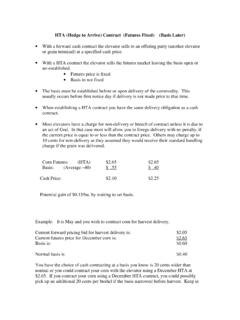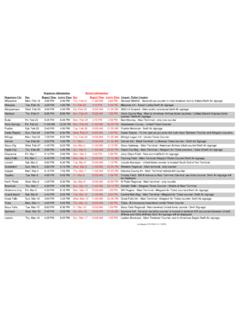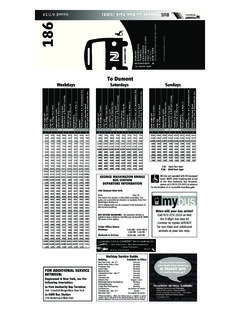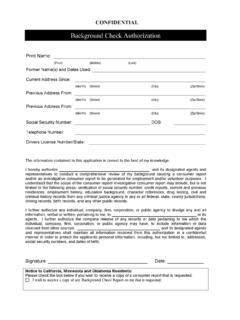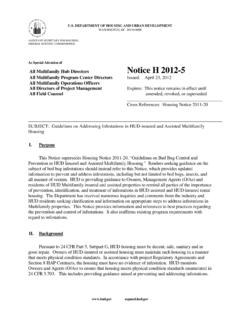Transcription of Optimizing Highway Transportation at the United States ...
1 Vol. 00, No. 0, Xxxxx 0000, pp. 000 000. INFORMS. doi issn 0092-2102 | eissn 1526-551X | 00 | 0000 | 0001 c 0000 INFORMS.. Optimizing Highway Transportation at the United States Postal Service Anthony Pajunas US Postal Service, 475 L'Enfant Plaza, SW, Washington , 20260, USA, Edward J. Matto IBM Global Business Services, 12902 Federal Systems Park Drive, Fairfax, VA 22033, USA, Michael Trick Tepper School of Business, Carnegie Mellon University, 5000 Forbes Avenue, Pittsburgh, PA 15213, USA, Luis F. Zuluaga Faculty of Business Administration, University of New Brunswick, PO Box 4400, Fredericton, NB E3B 5A3, CANADA, The United States Postal Service (USPS) delivers more than 200 billion items per year. Transporting these items in a timely and cost-efficient way is a key issue if USPS is to meet its service and financial goals. The Highway Corridor Analytic Program (HCAP) is a tool that aids Transportation analysts in identifying cost saving opportunities in the USPS surface Transportation network.
2 Use of this tool is resulting in millions of dollars of annual savings. Key words : parcel industry; Transportation network; large-scale integer programming; decision support system. History : 1. Introduction The Transportation network of the United States Postal Service (USPS) is extremely large and complex, and accordingly the Transportation planning process is an important and challenging component of USPS Logistics. The Highway Corridor Analytic Program (HCAP) has recently been developed to assist in the Transportation planning process. HCAP is an analytical model intended to aid Transportation analysts in identifying cost savings opportunities within the USPS surface Transportation network. The HCAP model is designed to solve the Vehicle Routing Problem with Pickups and Deliveries (VRP/PD), utilizing mixed integer programming as the underlying opti- mization engine. The HCAP model also incorporates a graphical user interface to facilitate the modeling process at USPS.
3 HCAP was designed to use existing data sources so the HCAP model can be used for near-term identification of savings opportunities. The HCAP model has been fully developed and tested, and has been deployed to USPS Transportation analysts in USPS Head- quarters and in the regional Area offices. Many of the recommendations that have been developed from HCAP model results have been implemented, resulting in annual Transportation savings of over $5 million already being realized at USPS during the early stages of HCAP deployment, with additional savings identified and currently under review. 2. Background The USPS operates one of the largest and most complex logistics networks in the world, deliver- ing more than 200 billion pieces of mail each year. The USPS surface Transportation network is 1. Pajunas et al.: Optimizing Highway Transportation at the USPS. 2 c 0000 INFORMS. 00(0), pp. 000 000, . actually comprised of many different networks, each designed for specific purposes.
4 USPS delivers many different types of mail, including letters, flats ( , large envelopes for unfolded documents), parcels, and periodicals. Different types of mail have different characteristics which determine the processing requirements. For example, letters, flats, and parcels all have different sizes, shapes, and weights, resulting in the need for specialized processing operations to accommodate those dif- ferences. USPS also offers several different mail classes, including Priority, First Class (overnight, 2-day, and 3-day), and Standard mail classes. Each mail class has specific service standards that define the overall delivery timeframe for that mail class. To accommodate the wide range of mail type and mail class options available to USPS customers, USPS has established many different Transportation networks. For example, the bulk mail network transports bulk mail ( , standard parcels, periodicals, and other bulk mail) through Bulk Mail Centers (BMCs); the Surface Transfer Center (STC) network is a Transportation network that consolidates mail through STC facilities for purposes of aggregating volumes; inter-plant Transportation carries mail among Processing and Distribution Centers (P priority mail is often trucked to Priority Mail Processing Cen- ters (PMPCs) for priority mail processing; and time-critical mail ( , Express mail and some First Class and Priority mail) is trucked from P&DCs to Air Mail Centers (AMCs) to enter the air Transportation network.)
5 Each of these Transportation networks was designed to serve a par- ticular purpose, but each network does not operate in isolation. Rather, significant overlap and redundancies exist among the various surface Transportation networks. For example, inter-P&DC. Transportation may stop at a BMC en-route between P&DCs, to get bulk mail from the origin P&DC into the bulk mail network. Similarly, STC Transportation may additionally stop at P&DCs to pick-up and drop-off inter-P&DC mail along the STC route. These multiple, intertwined trans- portation networks create significant complexities and challenges in USPS Transportation planning. The vast size of the USPS Transportation network further complicates the planning process. On an average weekday, for example, USPS may dispatch over 75,000 trips among over 30,000 facilities (including processing facilities, post offices, and other facilities) in the Highway Transportation net- work.
6 USPS employs a variety of advanced analytical tools and techniques to address the challenges of managing such a large and complex network. The HCAP model was developed to serve as a robust analytical tool to assist in the Transportation planning process. 3. Objectives The HCAP model was developed to assist USPS in analyzing surface Transportation routing and scheduling. The model serves as an analytical tool with which USPS can identify opportunities to reduce surface Transportation costs while maintaining on-time delivery. The model is intended to be sufficiently flexible so USPS can apply it to a wide range of components of the USPS Transportation network. For example, the HCAP model may be applied to problem sets that include BMCs, STCs, P&DCs, AMCs , and a variety of other Transportation applications. The model could also be applied to individual geographic regions of the nation ( , all processing facilities in the northeast corridor), or the model could be applied to a single Transportation network nationwide ( , all BMCs ), provided that the size of the network being considered is suitable for the HCAP model (see Section 4 for details).
7 Although the HCAP model is designed to be applicable to a wide variety of Transportation net- works, there is a standard problem definition that the model is designed to solve. Each problem must be defined by a set of delivery requirements among a set of facilities, and a set of trans- portation resources feasible to transport those deliveries. The HCAP model then optimizes the Transportation of the given set of delivery requirements, considering the potential Transportation options that can fulfill those delivery requirements. Therefore it is necessary to define, for each problem application, the specific delivery requirements and potential Transportation options avail- able. Delivery requirements may include both pickup and delivery requirements among a set of facilities, involving multiple types of mail with various service commitments. Pajunas et al.: Optimizing Highway Transportation at the USPS. c 0000 INFORMS.
8 00(0), pp. 000 000, 3. The HCAP model is intended to optimize existing Transportation ; that is, the model identifies opportunities to modify existing USPS Transportation to reduce costs. Although it is not intended as a means to completely self-generate new Transportation networks, new Transportation options can be considered by the model. For that purpose, it is possible to generate new Transportation alternatives using heuristics or operational insights, and incorporate them as potential options that the HCAP model may select when Optimizing the network. The solution to the HCAP model will then identify the optimal set of Transportation resources based on all options provided as inputs into the model, including existing Transportation and any new Transportation alternatives provided. 4. Modeling and Solution Approach The HCAP model is intended to optimize the use of a wide variety of components of the USPS.
9 Transportation network. For that purpose, the HCAP model is designed to solve a Vehicle Routing Problem with Pickups and Deliveries (VRP/PD) model, a special instance of the more general Vehicle Routing Problem (VRP) model (see Bodin and Golden (1981) for a classification of various VRP problems). VRP models intend to identify the optimal plan for routing deliveries among facilities. The underlying structure of the model consists of three primary components that can be described as follows: Facilities: are the (generally physical) places in the Transportation network. In the HCAP. model, the locations represent the places at which mail pickups and deliveries occur. For example, these can be P&DC's, STCs, AMCs and BMCs . Deliveries: are the items to be delivered between facilities. In the HCAP model, the deliveries represent the volume of mail that requires Transportation from an origin facility to a destination facility in a specific time window ( , the time between the moment the mail becomes available at the origin facility and the time the mail is required to be delivered at the destination facility).
10 Each delivery may likely represent a specific mail class, having a certain service standard between the origin and destination ( , First Class 3-day mail from New York to San Francisco). Two different types of deliveries are considered in the HCAP model. Splitable deliveries are those whose associated volume can be divided into different parts for delivery. Conversely, Unsplitable deliveries are those whose associated volume cannot be divided into different parts for delivery. Trips: are the mechanisms (routes) for moving deliveries. In the HCAP model, the trips repre- sent the different means that can be used to transport volume of mail from the origin facility to the destination facility within the required time window. Routes may be direct (from the origin directly to the destination), or multi-stop (stopping at one or more facilities en route from the origin to the destination). Each multi-stop route may pickup and/or deliver mail at any of the facilities along its path.






